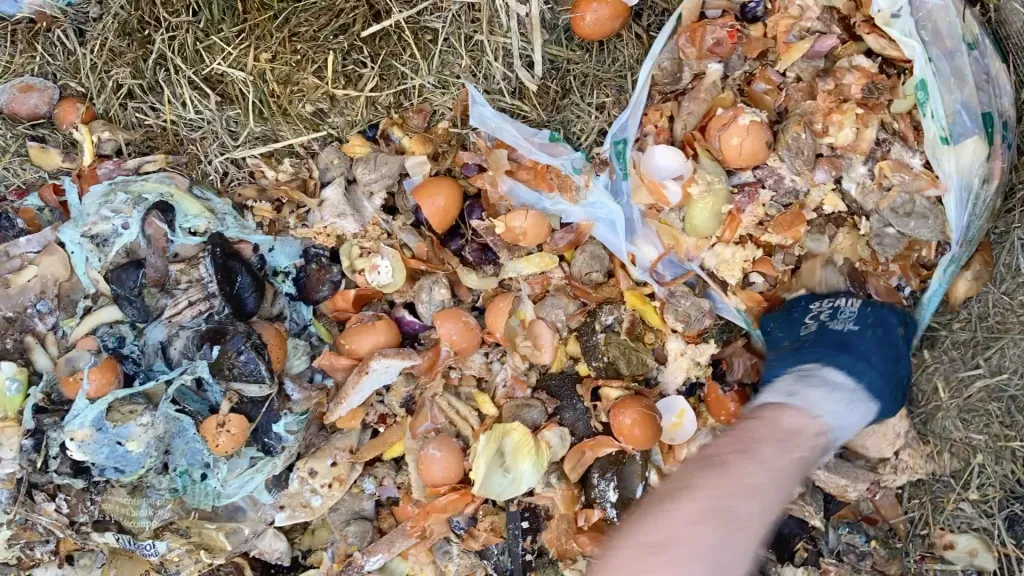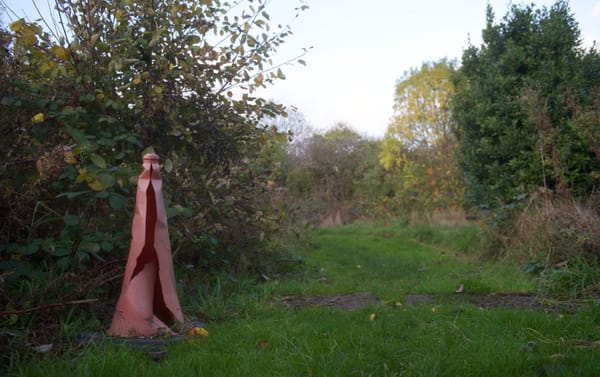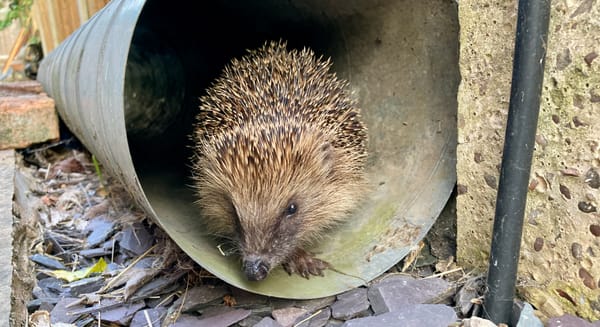The Aerobic Digest 11: Building a heap from scratch
I made a timelapse video of the compost bay being filled, and ponder the best way to bring life back to some dead soil.

Through a confluence of circumstance I had a LOT of compostables stacked up and a nice empty bay to receive them today. One friend who also has rabbits had delivered seven bin liners of poop and hay, while another friend who also runs a micro-scale food waste collection didn’t have time to deal with the 10 buckets that arrived on her doorstep from a neighbour who’d spend the week batch-cooking for Ramadan. Add this to a few weeks of my own backlog, plus the mountainous results of my enthusiastically using my new cardboard shredder (more on that another day!) and I reckoned I could fill the whole thing in one go.
Knowing this might happen I jerry-rigged a way to suspend my phone above the heap and made a timelapse of the layering process, which I have annotated for your elucidation. Hope you enjoy it!
As a video it’s a bit of a technical mess and I could definitely do better, but I’m more interested in composting than documenting composting right now. I do quite like how it get closer and closer to the camera until you’re right in there and I am a bit curious to see how it would work on a giant screen… No, I’m no longer a lens-based artist. The heap is the artwork, not the documentation. And documentation for documentation’s sake is the enemy. This is as good as I’m going to allow it to get.
Anyway, a nice full bin. I expect it to settle quickly and I can add plenty more over April before letting it rest.
Fiona and I spent a bit of time pondering the development of the lower half of the allotment today. We originally had a half plot but took over the other half a couple of years ago. Here’s an annotated aerial photograph of our plot taken from an online map provider.

We’ve cleared most of the crap off new area since this photo was taken, and Fi had sowed a wildflower cover crop to get some nutrients in there, but despite doing everything by the book, the first attempt to grow crops was weirdly poor. The topsoil seems OK so we did an experimental dig and discovered loads of chunks of bricks!
Our allotment was established on land previously used as a brick factory and we’re quite used to finding redbrick gravel in the beds. But this spot must have never been cleared properly, or is part of the old building foundation. (The lovely lawn next to our plot is there purely because the topsoil quickly hits brick.) It’s no wonder the plants could only establish shallow roots.
We’re going to have to dig this whole area over and remove the bricks, probably down to a good half metre. Normally I’d be concerned about disturbing the soil structure, but there’s no structure to speak of and hardly any life. The soil smells of nothing, which is a bit odd when you realise it.
The end result will be a bed of loose soil with a lot of brick fragments and it’s going to need a decent amount of amending. And so, mes amis, we’re going to do some hügelkultur after all!
(Or maybe we’ll just dig in that pile of horse manure we got last year but haven’t figured out what to do with yet. Yeah. That makes much more sense.)
A tour of a worm farm
My hot composting process mostly produces mulch - rough compost that we spread on the beds which the worms then pull into the soil to finish off. I know very little about actual vermicomposting (to the point where for a while I thought it meant composting with vermin, however that might work) where you create composting structures specifically targeted at worms.
This video, made during a workshop at the Arizona Worm Farm, is therefore fascinating to me. It also has the bonus of being of somebody who has explained this stuff over and over and over and has it down pat. I particularly liked “browns are anything that was once a tree”. Boom.
I still think vermicomposting is a bit of an attention sink. One thing I like about composting in heaps is you can leave them for decent periods of time and they’ll be perfectly OK. With worms farms I get the sense you have to look after them in an animal husbandry kind of way, and I already do that with the rabbits.
Municipal composting advocacy
Composting Makes Sense. Why Don’t More Cities Do It? This is a great article on Modern Farmer which looks at some actual community- and city-scale composting schemes across the US and how they came about. Useful if you need to convince someone up the chain to fund your project! (via)
Modern Farmer looks like it has some great resources. I quickly came across this interview with a guy who wanted to set up a community composting scheme but faced outdated zoning laws prohibiting food waste processing, presumably because they put it in the same category as setting up a landfill site or sewage treatment works. Of course it’s totally possible to cleanly compost food waste in an urban location if you do it appropriately.
We opted for a rotating drum composter. Our goal was to just get our foot in the door in whatever municipality we ended up working in. And to do that, we wanted to make sure our process was as clean and efficient as possible so that we would allay any fears about possible rodents or pests or bad smells. So, we spent a lot of money to make sure that we didn’t run into any perception issues. Our main goal is to kind of make the perception of composting seem cool and achievable.
I wonder what the zoning laws are like in my city (Birmingham UK)? My chum Jez messaged me recently to say when his wife was managing Britain In Bloom for the suburb of Moseley a decade or so ago, she wanted to compost scraps from all the local restaurants, something I’ve been pondering for my area, but food waste was considered hazardous material and could not be handled within half a kilometre of any residential dwellings. Which is of course impossible in a city.
The great green wall of Africa
There’s a good chance you’ve already heard about this – it’s been all over my internet at least. The Sahara desert is spreading south at an alarming rate and the Great Green Wall is a massive project to stop it. How do you stop a desert? With thousands of small round beds designed to hold moisture and plants to build soil structure.
I will admit to being incredibly cynical about this when I first heard about it as it seems far too good to be true – like those greenwashing “plant a shittonne of trees to save the planet” things – but the project looks solid and from what I can tell it’s working. Amazing stuff!
Tips to speed up composting
It’s worth preceding this with a reassurance that slow composting is perfectly fine. In fact it’s probably the best sort of composting because it’s the most natural and allows the micro-organisms to work at their own pace. In nature, plants die and fall to the ground and it takes a while for the soil biome to process them into food.
The main reason people like me might want to speed up our compost process is because we tend to be processing a lot of material in a smaller space and want to get it done before we get more material delivered. If that’s not you then don’t worry, it’ll be done when it’s done.
Like most articles written to get traffic from Google, How To Speed Up Composting (10 Tips For Faster Results) takes the long route to communicate some fairly simple things, but it does have this great diagram, which I’m totally in love with.

It’s so out of place that I assumed it was nicked from elsewhere, maybe some awesome composting comic, but there’s nothing on TinEye. As you’ll know I’m a big fan of the perforated drainpipe so it’s lovely to see it.
Bristol Living Soil
“We want to regenerate Bristol’s soils, rebuild community and share knowledge” says Lara Luna Bartley of the Bristol Living Soil community compost collective who have a great logo.

Their business model is based on a subscription of minimum £10 a month in return for which you get an annual delivery of high quality compost. It looks like they’re using those big octagonal tumblers and say they have capacity to process “food waste from 20-30 households and 5-8 businesses on our current site.” So not quite community-scale but not nothing either. Although from a sustainability point of view that’s not going to generate enough income to pay anyone a decent wage to manage the scheme.
I’d be interested to see how much they produce in a year. If I had those inputs I might get 3000 litres of compost? Maybe more? So based on a totally arbitrary reckon, each person would get about 100 litres of compost for £120. Standard compost from our local garden centre is £4 for 10 litres, so it’s probably not competitive with that, but it’s also probably not the point - this is aimed at people who want to do something to make a difference and the compost is a bonus. Plus unlike Birmingham, Bristol actually has council food waste collections.
More interesting is the commercial angle. At my bakery we pay Biffa £90 (inc VAT) a month for weekly collections of a 240 litre wheelie bin. If this was being collected and processed locally for roughly the same amount we’d certainly be interested.
Anyway, I’m picking at the details because I’m really intrigued how something like this could be expanded to 200-300 homes and 50-80 businesses. Regardless, it’s fantastic to see this happening in Bristol. Next time I find myself visiting the land of (some of) my youth I’ll try to arrange a visit.
That’ll do for this issue. The next issue will be out the next time I do some composting!
Please continue to send compost-related things to info@aerobicdigest.email or @ me on Mastodon where I keep tabs on the #compost tag.
Your friend in rotting vegetable matter,
Pete Ashton



